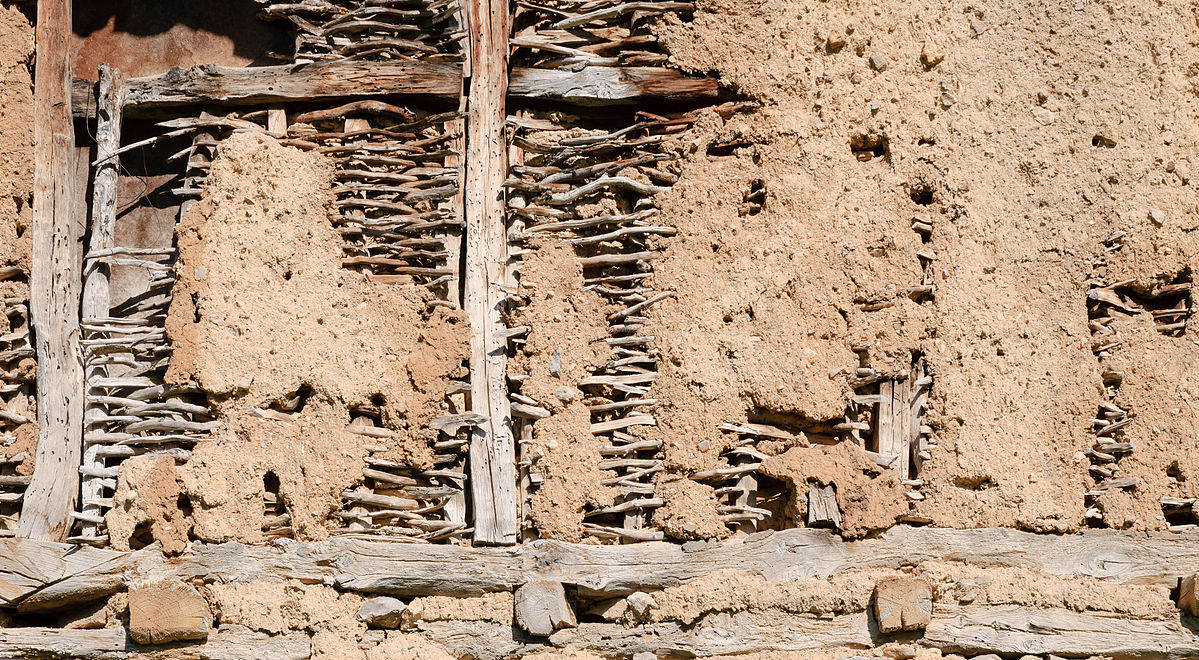Wattle and daub

|
| The old wattle and daub construction system found at the 19th century Razboishte monastery, Bulgaria. By MrPanyGoff [CC BY-SA 3.0 (https://creativecommons.org/licenses/by-sa/3.0)], from Wikimedia Commons |
Wattle and daub is a composite building technique that has be used for wall construction for thousands of years. It consists of a woven lattice (the ‘wattle’) which is daubed with a sticky filler material.
Wattle is typically formed by wooden strips or thin branches woven between upright stakes. Other materials that can be used as wattle include reeds, vines, and bamboo, and it can aso be formed as a loose panels slotted between timber framing.
Daub is typically formed from mud plaster made from a combination of wet soil, clay, sand, animal dung and straw. For more information, see Daub.
Once the daub has been applied to the wattle (sometimes in more than one layer) and left to completely dry, it may be whitewashed to give it better resistance to rain, increase its solar reflectance and enhance its appearance.
Wattle and daub is still used in many regions of the world but in modern architecture it became superseded by lath and plaster for wall and ceiling applications, and more recently by plasterboard. However, it has become more prevalent again with the rise in popularity of sustainable building techniques and materials.
[edit] Related articles on Designing Buildings
Featured articles and news
RTPI leader to become new CIOB Chief Executive Officer
Dr Victoria Hills MRTPI, FICE to take over after Caroline Gumble’s departure.
Social and affordable housing, a long term plan for delivery
The “Delivering a Decade of Renewal for Social and Affordable Housing” strategy sets out future path.
A change to adoptive architecture
Effects of global weather warming on architectural detailing, material choice and human interaction.
The proposed publicly owned and backed subsidiary of Homes England, to facilitate new homes.
How big is the problem and what can we do to mitigate the effects?
Overheating guidance and tools for building designers
A number of cool guides to help with the heat.
The UK's Modern Industrial Strategy: A 10 year plan
Previous consultation criticism, current key elements and general support with some persisting reservations.
Building Safety Regulator reforms
New roles, new staff and a new fast track service pave the way for a single construction regulator.
Architectural Technologist CPDs and Communications
CIAT CPD… and how you can do it!
Cooling centres and cool spaces
Managing extreme heat in cities by directing the public to places for heat stress relief and water sources.
Winter gardens: A brief history and warm variations
Extending the season with glass in different forms and terms.
Restoring Great Yarmouth's Winter Gardens
Transforming one of the least sustainable constructions imaginable.
Construction Skills Mission Board launch sector drive
Newly formed government and industry collaboration set strategy for recruiting an additional 100,000 construction workers a year.
New Architects Code comes into effect in September 2025
ARB Architects Code of Conduct and Practice available with ongoing consultation regarding guidance.
Welsh Skills Body (Medr) launches ambitious plan
The new skills body brings together funding and regulation of tertiary education and research for the devolved nation.
Paul Gandy FCIOB announced as next CIOB President
Former Tilbury Douglas CEO takes helm.
UK Infrastructure: A 10 Year Strategy. In brief with reactions
With the National Infrastructure and Service Transformation Authority (NISTA).






















